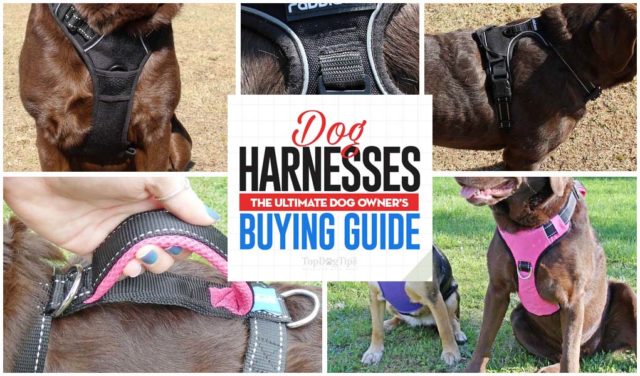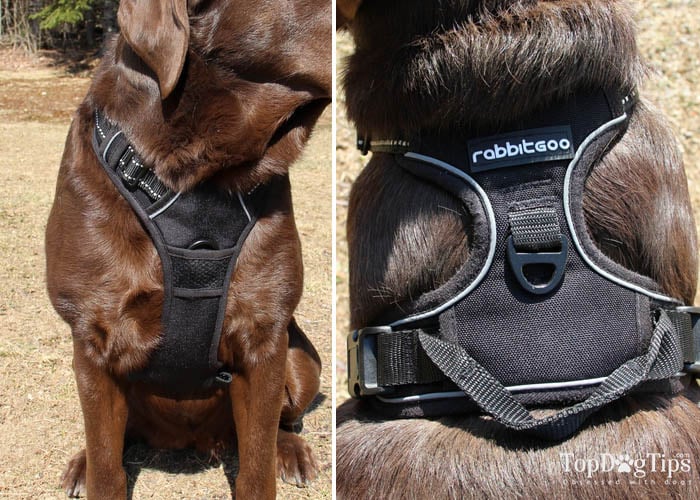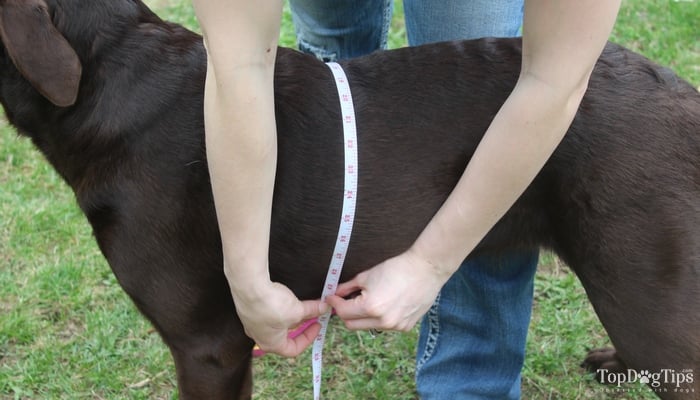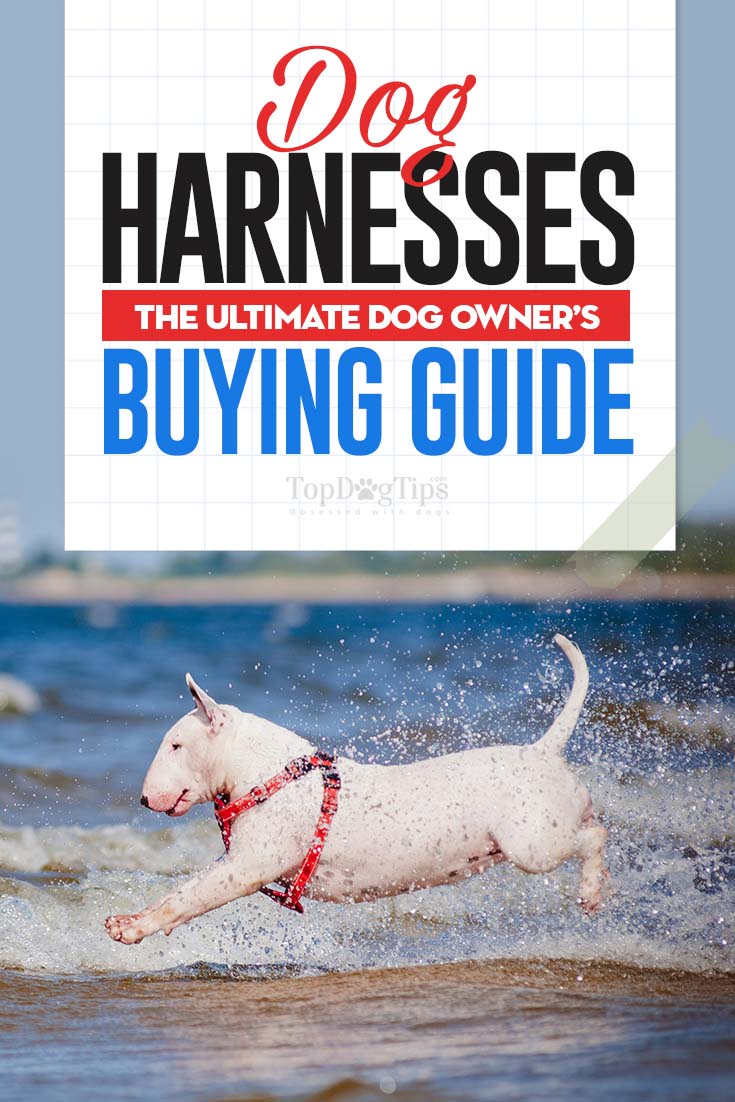
Table of Contents
A dog harness is a fantastic tool when used correctly, but some people buy the wrong thing. There are different types, sizes, and uses of dog harnesses, and here's what you should know about them.
Why Choose a Dog Harness Over a Leash
When on a leash, dogs that pull a lot run the risk of increasing blood pressure flowing to their eyes, straining or spraining their neck, and breaking their larynx and trachea, according to a 2006 study.
Moreover, because owners have less control over the dog when using a leash, there's an increased risk to both dogs and owners walking them, according to another study.

This is because a collar only provides a singular point of control, whereas a harness redistributes your dog’s pulling force and momentum more evenly and over multiple points of control. But even among harnesses, some types are better than others at delivering this result.
Dog harnesses are also less likely to break away or slip off when your dog is compelled to run.
Less confident dogs can find comfort and security from the way that a harness wraps around their body.
This increased confidence makes your dog more receptive to your commands and less fearful of new environments.
The bottom line is that a dog harness is generally safer and more comfortable for the dog and the owner than a regular dog leash.
Front-clip vs. Back-clip vs. Dual-clip Harnesses

A back-clip dog harness has a D-ring (leash attachment) on the back, between the shoulder blades.
It offers more control than a leash, but less control than a front-clip harness. It creates a single anchor point for the dog to pull their owner behind them.
Back-clip harnesses are best for:
- Small dogs
- Dogs with respiratory or trachea problems
- Dogs with neck injuries
Back-clip harnesses are not ideal for:
- Dogs that pull excessively
- Large dogs with a high prey drive and little training
- Dogs with a lot of power
For example, a 200-pound bull mastiff who has not yet been trained to walk on a leash and who pulls excessively would not benefit more from a back-clip harness, but it'd be a great choice for a small old Yorkie.

A front-clip dog harness has the D-ring on the front, in the center of the chest. A front clip allows more control of the dog’s forward motion and direction, and you'll see that most no-pull harnesses are front-clip.
Front-clip harnesses are best for:
- Dogs that pull
- Dogs that jump
- Dogs that get distracted and are hard to direct when walking
Front-clip harnesses are not ideal for:
- Dogs with serious behavioral concerns like aggression or uncontrolled prey drive
For example, a Golden Retriever with aggression would not do well with a front-clip harness because it doesn't provide enough control over an animal with serious behavioral issues.
However, it would be a good choice for a Labrador Retriever who walks well on a leash but may get over-excited and pull when they get distracted.

A dual-clip (or multi-clip) dog harness has a D-ring on both front and back. Some types have even more than two D-ring attachments.
This type is obviously more versatile. They used to be only popular among dog trainers, but more pet owners are now buying them as well.
These harnesses combine all the advantages of the back-clip and front-clip styles mentioned above. However, there are still three disadvantages to a multi-clip harness:
(a) They're more expensive
(b) Some dogs may find them uncomfortable due to multiple D-ring attachments
(c) Dog trainers don't recommend using them due to over-dependency on this type of harness because the dog must learn how to walk properly without the use of it.
Generally, it's best to use a dual/multi-clip harness only for a short term while training and then switch to one of the two above.
What Type of Dog Harness Do You Need?
Besides the location of the leash clip attachment on the harness and the “regular” type of dog harnesses, there are also a few other, more unique types, and they serve different purposes in terms of control of the dog.

The Mobility Harness
A mobility dog harness, also known as a dog sling harness, is a harness designed to assist a dog with limited mobility.
This type of harness can feature a hip-lift handle, a back handle, wraparound handles, or a strap that passes from the front to the back of the harness.
All sling harnesses are made and designed to support a dog with hip dysplasia, joint degeneration, limited mobility, or joint injuries.
Mobility dog harnesses are best for:
- Larger dogs with joint injuries
- Dogs recovering from surgery
- Older dogs with limited mobility
A 90-pound German Shepherd who has recently undergone a CCL repair surgery would be the perfect candidate for a mobility harness.
Mobility harnesses can be used with most breeds, but certain types of these harnesses are best suited to certain types of dogs.
For example, a sling harness with a strap from front to back is better suited for a small dog or dog with short stature, like a Beagle.
The one with a hip lift and back handle is better for medium to large breeds with stiffness in all joints or injuries in hind legs.
A harness with a hip lift handle is only best for large breeds with difficulty in their hind legs.
Those with wraparound handles are best for large female dogs with difficulty with all four legs or the hind legs only.

The Tightening Harness (somewhat controversial)
A tightening dog harness is a harness that tightens and applies pressure to the dog when they pulls or jumps. This pressure discourages negative behaviors, such as jumping at people, by creating slight discomfort as it tightens (safely).
Tightening dog harnesses are best for:
- Stubborn pullers
- Regular jumpers
Tightening dog harnesses are not ideal for:
- Timid dogs or dogs with a history of abuse
- Dogs that do not respond well to corrective training
For example, a Poodle with a history of abuse would not do well on a tightening harness.
Although minimal, the discomfort caused by the harness tightening can cause a formerly abused dog to regress or act out.
On the other hand, a Pit Bull that regularly jumps to greet strangers while on a walk might need the tightening harness type.

The Head Harness (controversial)
A head dog harness is often referred to as a “head collar.” Rather than fit around the body, this harness fits around the dog’s muzzle and head.
Like the tightening one, the head harness creates pressure to discourage negative behavior.
This harness also provides more control over a dog’s direction by controlling head direction and movement, much like a horse’s bridle.
Similar to dog muzzles, there is some controversy over the potential of a head harness to cause damage to a dog’s neck but also similar to muzzles, such a harness may be needed for certain dogs, especially if there are laws requiring them to wear it.
Fortunately, when used correctly without force, a head harness can be effective and safe for training.
Head dog harnesses are best for:
- Patient and experienced dog trainers
- Persistent pullers
- Dogs that are easily distracted
Head dog harnesses are not ideal for:
- Owners who are quick to get frustrated
- Dogs with respiratory difficulties
- Dogs with short muzzles
For example, English Bulldogs are not suited for this type of harness because their small muzzle does not accommodate a head harness well.
A Golden Doodle that consistently pulls and does not respond to a traditional tightening harness would do well with a head harness.
The head muzzle creates more control and direction for a dog that lacks both.
Proper Fit for a Dog Harness
Different types will fit your pet differently. Depending on your dog's build, some will be better than others, and you'll find that it's also easier/harder to fit your dog type of harness on your dog than the others.
Common fit types of dog harnesses are below.
The Step-In Harness
A step-in dog harness resembles a figure eight in design. The dog simply steps into the harness, and it clips at the back.
Step-in dog harnesses are best for:
- Smaller or lighter breed dogs
- Older dog owners with less manual dexterity
Unfortunately, step-in harnesses are almost exclusively made for small breeds. They can be found for larger dogs, but there isn't much of a selection.
The Roman Harness
A Roman dog harness has two straps – one that fits around the dog’s chest and one that fits around the shoulder blades. These two straps are joined along the back and under the chest.
Roman harnesses are best for the same dogs as the back-clip harness.
Roman harnesses are not for owners who have difficulty with fine motor skills, arthritis, or confusion.
The Roman harness proves more of a challenge to “untangle” and put onto a dog.
The Durability or Strength of a Dog Harness
There are two common levels of strength and durability of a dog harness.
A single-ply pet harness is constructed with a single layer of material. This material is most often nylon webbing, but it may also be leather.
A two-ply dog harness is constructed with two layers of material. As with the single-ply harness, this material can be nylon or leather.
Obviously, the 2-ply dog harness is much stronger than the single-ply dog harness and is recommended for large dog breeds or dogs with a significant amount of pulling force.
How to Measure a Dog for a Harness
It’s crucial to measure your dog correctly for their harness and then put it on properly.
A dog harness that is too loose provides little control, and the possibility of escape, and a harness that is too tight creates discomfort, pain, and risk of injuries.
There are two measurements you need for most harnesses – the lower neck and chest.
Using a soft measuring tape, measure around the lower portion of your dog’s neck. Place the measuring tape just above the breastbone and around the back of the neck.
Using a soft measuring tape, measure around the widest part of your dog’s chest.
For most dogs, this means placing the measuring tape just behind the front legs and wrapping it around to your dog’s back.
Many dog harnesses use the term “girth” when referencing your dog’s measurements. Girth is the same as your dog’s chest measurement around the widest part of their chest.
 It is always best to account for a little “give” when fitting your dog’s harness to prevent chafing and pinching.
It is always best to account for a little “give” when fitting your dog’s harness to prevent chafing and pinching.
The general rule of thumb is to allow for no more than “two fingers” of space between your dog and the straps of their harness.
Some harnesses for dogs are sold based on weight. Avoid this type of harness since it will not fit optimally.
Buy your dog’s harness based on their measurements instead.
For example, a mixed breed terrier that weighs 45 pounds but has a 27” chest may require the same size harness as a 60-pound Dalmatian that also has a 27” chest.
Good Quality Dog Harnesses to Consider
Due to the popularity of many different harnesses for dogs that are available, buying the right one can be confusing.
The above information should help you pinpoint the exact type of pet harness you need.
The only time you may need to buy a more specific harness is for using it in a car.
For that, it's best to use a crash-tested dog harness, but there are only a few options out there that have been tested and approved by an independent entity.
For regular walking and training, below are some of the best dog harnesses (in different styles/types), which we've ranked below after reviewing them on Top Dog Tips.
| Dog Harness Brand | Dog Harness Type | Notes |
| Freedom No-Pull Harness | Front-clip and back-clip, tightening, Roman harness | Good for pullers and a large size range (XS – 2X) |
| PetSafe Sure-Fit Harness | Back-clip, Roman harness | It is good for pullers, has a limited size range, and is confusing to fit. |
| PetSafe Gentle Leader Head Harness | Front-clip, head harness | It is good for pullers and easily distracted dogs, but it is confusing to fit. |
| Dog Lifting Aid Mobility Harness | Back-clip, rear, and hip lift mobility harness | It is an expensive but top-of-the-line mobility harness. |
| Kurgo Tru-Fit Walking Harness | Front-clip and back-clip, Roman harness | Chest plate for force distribution, quick-release side buckles. |
| Escape Resistant Harness Lead | Back-clip, tightening, over-the-head harness | Escape-proof, confusing to fit. |
| Gooby Escape Free Harness | Back-clip, tightening, step-in harness | Escape-proof, limited sizing (up to 23.5” chest and 21.75” neck). |
Disclosure: We may earn affiliate commissions at no cost to you from the links on this page. This did not affect our assessment of products. Read more here and find full disclosure here.
Want to share it?















